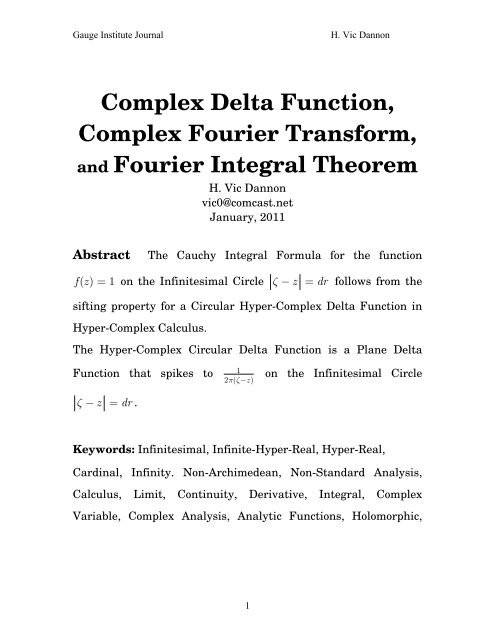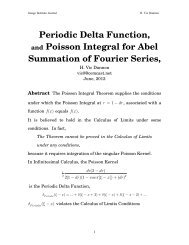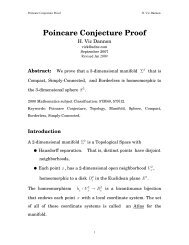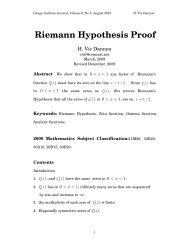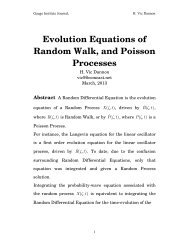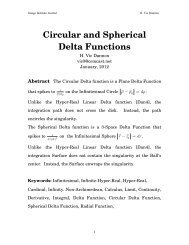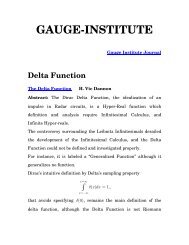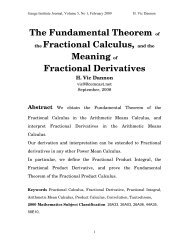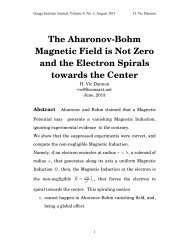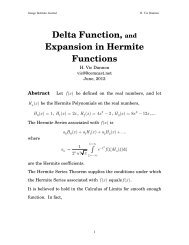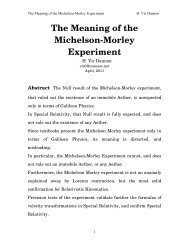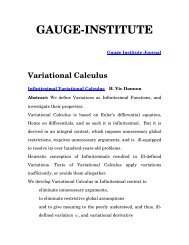Circular Complex Delta Function - Gauge-institute.org
Circular Complex Delta Function - Gauge-institute.org
Circular Complex Delta Function - Gauge-institute.org
Create successful ePaper yourself
Turn your PDF publications into a flip-book with our unique Google optimized e-Paper software.
<strong>Gauge</strong> Institute Journal H. Vic Dannon<br />
<strong>Complex</strong> <strong>Delta</strong> <strong>Function</strong>,<br />
<strong>Complex</strong> Fourier Transform,<br />
and Fourier Integral Theorem<br />
H. Vic Dannon<br />
vic0@comcast.net<br />
January, 2011<br />
Abstract The Cauchy Integral Formula for the function<br />
f () z = 1on<br />
the Infinitesimal Circle ζ − z = dr<br />
follows from the<br />
sifting property for a <strong>Circular</strong> Hyper-<strong>Complex</strong> <strong>Delta</strong> <strong>Function</strong> in<br />
Hyper-<strong>Complex</strong> Calculus.<br />
The Hyper-<strong>Complex</strong> <strong>Circular</strong> <strong>Delta</strong> <strong>Function</strong> is a Plane <strong>Delta</strong><br />
<strong>Function</strong> that spikes to<br />
ζ − z = dr.<br />
1<br />
2 πζ− ( z)<br />
on the Infinitesimal Circle<br />
Keywords: Infinitesimal, Infinite-Hyper-Real, Hyper-Real,<br />
Cardinal, Infinity. Non-Archimedean, Non-Standard Analysis,<br />
Calculus, Limit, Continuity, Derivative, Integral, <strong>Complex</strong><br />
Variable, <strong>Complex</strong> Analysis, Analytic <strong>Function</strong>s, Holomorphic,<br />
1
<strong>Gauge</strong> Institute Journal H. Vic Dannon<br />
Cauchy Integral Theorem, Cauchy Integral Formula, Contour<br />
Integral.<br />
2000 Mathematics Subject Classification 26E35; 26E30;<br />
26E15; 26E20; 26A06; 26A12; 03E10; 03E55; 03E17; 03H15;<br />
46S20; 97I40; 97I30.<br />
Contents<br />
Introduction<br />
1. Hyper-<strong>Complex</strong> Plane<br />
2. Hyper-<strong>Complex</strong> Path Integral<br />
3. <strong>Circular</strong> Hyper-<strong>Complex</strong> <strong>Delta</strong><br />
4. <strong>Circular</strong> <strong>Delta</strong> <strong>Function</strong> Plots<br />
5. <strong>Circular</strong> <strong>Delta</strong> Properties<br />
6. Primitive and Derivatives of the <strong>Circular</strong> <strong>Delta</strong><br />
7. δ (()) f z<br />
8. Circulation of the <strong>Circular</strong> <strong>Delta</strong><br />
9. Sifting by ( z , and<br />
δ ζ − ) d δCircle ( ζ − z)<br />
Circle<br />
10. Representing f () z by Cauchy Integral Formula<br />
11. Fourier Transform of<br />
δ()<br />
z<br />
12. Fourier Integral Theorem for f () z<br />
References<br />
dz<br />
2
<strong>Gauge</strong> Institute Journal H. Vic Dannon<br />
Introduction<br />
For z in the interior of γ , Cauchy Integral Formula gives an<br />
analytic<br />
Thus,<br />
f () z as the convolution of f with<br />
1 1<br />
2πi ζ− z<br />
1 1<br />
2πiζ .<br />
1 1<br />
f () z = ∫ f()<br />
ζ d ζ<br />
2πi<br />
ζ − z<br />
γ<br />
recovers the value of a complex function f () ζ at the<br />
point z in the interior of a loop γ , by sifting through the values of<br />
f () ζ on γ .<br />
If the integration path is the infinitesimal circle<br />
the sifting is performed by<br />
1 1<br />
2 i − z<br />
ζ − z = dr,<br />
{ ζ z dr} () ζ δCircle( ζ z)<br />
.<br />
π ζ χ − = ≡ −<br />
We call δ ( ζ − z)<br />
the Hyper-<strong>Complex</strong> <strong>Circular</strong> <strong>Delta</strong> <strong>Function</strong>.<br />
Circle<br />
Unlike the Hyper-Real Linear <strong>Delta</strong> function [Dan4], the<br />
integration path does not cross the Infinitesimal Hyper-<strong>Complex</strong><br />
disk. Instead, the path encircles the singularity.<br />
In [Dan7], we showed that<br />
3
<strong>Gauge</strong> Institute Journal H. Vic Dannon<br />
∫<br />
ζ−<br />
z = dr<br />
1 1<br />
dζ<br />
= 1.<br />
2πi<br />
ζ − z<br />
Due to 1<br />
, the <strong>Complex</strong> <strong>Delta</strong> spikes to<br />
ζ − z<br />
1 1 1<br />
ζ<br />
= e<br />
2πidζ 2πidr<br />
on the infinitesimal Circle ζ − z = dr.<br />
−iArg( −z)<br />
The primitive of the <strong>Complex</strong> <strong>Delta</strong> on the Circle is<br />
1<br />
Log( ζ − z)<br />
,<br />
2πi<br />
and the derivative of the <strong>Complex</strong> <strong>Delta</strong> on the disk is<br />
1 1<br />
2 πi ( ζ − z)<br />
Since on the infinitesimal circle, ζ − z is a hyper-complex<br />
−iArg( ζ−z)<br />
infinitesimal ( dr) e , we recall the Hyper-<strong>Complex</strong> Plane<br />
that we introduced in [Dan7].<br />
4<br />
2<br />
.
<strong>Gauge</strong> Institute Journal H. Vic Dannon<br />
1.<br />
Hyper-<strong>Complex</strong> Plane<br />
Each complex number α + iβ<br />
can be represented by a Cauchy<br />
sequence of rational complex numbers,<br />
so that r + is → α + iβ.<br />
n n<br />
r + is , r + is , r + is ...<br />
1 1 2 2 3 3<br />
The constant sequence ( α + iβ, α + iβ, α + iβ,...)<br />
is a Constant<br />
Hyper-<strong>Complex</strong> Number.<br />
Following [Dan2] we claim that,<br />
1. Any set of sequences ( ι + iο , ι + iο , ι + iο<br />
,...) , where<br />
( ι1, ι2, ι3,...)<br />
belongs to one family of infinitesimal hyper reals,<br />
and ( ο , ο , ο ,...) belongs to another family of infinitesimal<br />
1 2 3<br />
hyper-reals, constitutes a family of infinitesimal hyper-<br />
complex numbers.<br />
1 1 2 2 3 3<br />
2. Each hyper-complex infinitesimal has a polar representation<br />
iφ<br />
( ) * , where is an infinitesimal, and<br />
iφ<br />
dz = dr e = ο e<br />
dr = ο*<br />
φ =<br />
arg( dz)<br />
.<br />
5
<strong>Gauge</strong> Institute Journal H. Vic Dannon<br />
3. The infinitesimal hyper-complex numbers are smaller in<br />
length, than any complex number, yet strictly greater than<br />
zero.<br />
1 1 1<br />
4. Their reciprocals ( , , ,...<br />
ι1+ iο1 ι2+ iο2 ι3+ iο<br />
) are the infinite hyper-<br />
3<br />
complex numbers.<br />
5. The infinite hyper-complex numbers are greater in length<br />
than any complex number, yet strictly smaller than infinity.<br />
6. The sum of a complex number with an infinitesimal hyper-<br />
complex is a non-constant hyper-complex.<br />
7. The Hyper-<strong>Complex</strong> Numbers are the totality of constant<br />
hyper-complex numbers, a family of hyper-complex<br />
infinitesimals, a family of infinite hyper-complex, and non-<br />
constant hyper-complex.<br />
8. The Hyper-<strong>Complex</strong> Plane is the direct product of a Hyper-<br />
Real Line by an imaginary Hyper-Real Line.<br />
9. In Cartesian Coordinates, the Hyper-Real Line serves as an<br />
x<br />
line.<br />
coordinate line, and the imaginary as an iy coordinate<br />
10. In Polar Coordinates, the Hyper-Real Line serves as a<br />
Range r line, and the imaginary as an i θ coordinate. Radial<br />
symmetry leads to Polar Coordinates.<br />
6
<strong>Gauge</strong> Institute Journal H. Vic Dannon<br />
11. The Hyper-<strong>Complex</strong> Plane includes the complex<br />
numbers separated by the non-constant hyper-complex<br />
numbers. Each complex number is the center of a disk of<br />
hyper-complex numbers, that includes no other complex<br />
number.<br />
12. In particular, zero is separated from any complex<br />
number by a disk of complex infinitesimals.<br />
13. Zero is not a complex infinitesimal, because the length<br />
of zero is not strictly greater than zero.<br />
14. We do not add infinity to the hyper-complex plane.<br />
15. The hyper-complex plane is embedded in , and is<br />
not homeomorphic to the <strong>Complex</strong> Plane . There is no bi-<br />
continuous one-one mapping from the hyper-complex Plane<br />
onto the <strong>Complex</strong> Plane.<br />
16. In particular, there are no points in the <strong>Complex</strong> Plane<br />
that can be assigned uniquely to the hyper-complex<br />
infinitesimals, or to the infinite hyper-complex numbers, or<br />
to the non-constant hyper-complex numbers.<br />
17. No neighbourhood of a hyper-complex number is<br />
homeomorphic to a ball. Therefore, the Hyper-<strong>Complex</strong><br />
Plane is not a manifold.<br />
n<br />
7<br />
∞
<strong>Gauge</strong> Institute Journal H. Vic Dannon<br />
18. The Hyper-<strong>Complex</strong> Plane is not spanned by two<br />
elements, and is not two-dimensional.<br />
8
<strong>Gauge</strong> Institute Journal H. Vic Dannon<br />
2.<br />
Hyper-<strong>Complex</strong> Path Integral<br />
Following the definition of the Hyper-real Integral in [Dan3],<br />
the Hyper-<strong>Complex</strong> Integral of f () z over a path zt () , t ∈ [ αβ , ] , in<br />
its domain, is the sum of the areas<br />
rectangles with base z '( t) dt = dz , and height f () z .<br />
f ()'() zz tdt= fzdzt () () of the<br />
2.1 Hyper-<strong>Complex</strong> Path Integral Definition<br />
Let f () z be hyper-complex function, defined on a domain in the<br />
Hyper-<strong>Complex</strong> Plane. The domain may not be bounded.<br />
f () z may take infinite hyper-complex values, and need not be<br />
bounded.<br />
Let zt () , t ∈ [ αβ , ] , be a path, γ(,) ab , so that dz = z '( t) dt , and z'( t)<br />
is continuous.<br />
For each t , there is a hyper-complex rectangle with base<br />
[() zt − ,( zt)<br />
+ , height f () z , and area f (()) zt dzt () .<br />
2<br />
2 ]<br />
dz dz<br />
We form the Integration Sum of all the areas that start at<br />
z( α ) = a , and end at z( β ) = b,<br />
9
<strong>Gauge</strong> Institute Journal H. Vic Dannon<br />
∑<br />
t∈[<br />
αβ , ]<br />
f (()) zt dzt () .<br />
If for any infinitesimal dz = z '( t) dt , the Integration Sum equals<br />
the same hyper-complex number, then<br />
Integrable over the path γ(,)<br />
ab .<br />
f () z is Hyper-<strong>Complex</strong><br />
Then, we call the Integration Sum the Hyper-<strong>Complex</strong> Integral of<br />
f () z over the γ(,)<br />
ab , and denote it by<br />
∫<br />
γ(,)<br />
ab<br />
f () zdz.<br />
If the hyper-complex number is an infinite hyper-complex, then it<br />
equals<br />
∫<br />
γ(,)<br />
ab<br />
f () zdz.<br />
If the hyper-complex number is finite, then its constant part<br />
equals<br />
∫<br />
γ(,)<br />
ab<br />
f () zdz.<br />
The Integration Sum may take infinite hyper-complex values,<br />
such as 1 , but may not equal to ∞ .<br />
dz<br />
The Hyper-<strong>Complex</strong> Integral of the function<br />
that goes through z = 0 diverges.<br />
fz ()<br />
2.2 The Countability of the Integration Sum<br />
1<br />
= over a path<br />
z<br />
In [Dan1], we established the equality of all positive infinities:<br />
10
<strong>Gauge</strong> Institute Journal H. Vic Dannon<br />
We proved that the number of the Natural Numbers,<br />
Card , equals the number of Real Numbers, 2 , and<br />
Card<br />
Card =<br />
we have<br />
2 Card<br />
2<br />
Card<br />
Card = ( Card)<br />
= .... = 2 = 2 = ... ≡ ∞.<br />
In particular, we demonstrated that the real numbers may be<br />
well-ordered.<br />
Consequently, there are countably many real numbers in the<br />
interval [ αβ , ] , and the Integration Sum has countably many<br />
terms.<br />
While we do not sequence the real numbers in the interval, the<br />
summation takes place over countably many f () zdz.<br />
2.3 Continuous f () z is Path-Integrable<br />
Hyper-<strong>Complex</strong> f () z Continuous on D is Path-Integrable on D<br />
Proof:<br />
Let zt () , t ∈ [ αβ , ] , be a path, γ(,) ab , so that dz = z '( t) dt , and z'( t)<br />
is continuous. Then,<br />
( ( )) '( ) = ( ( ( ), ( )) + ( ( ), ( )) )( '( ) + '( ))<br />
f z t z t u x t y t iv x t y t x t iy t<br />
= ⎡uxt ((), yt ()) x'() t −vxt<br />
((), yt ()) y'() t ⎤<br />
⎣ ⎦<br />
+<br />
Ut ()<br />
11
<strong>Gauge</strong> Institute Journal H. Vic Dannon<br />
+ iuxt ⎡ ((), yt ()) y'() t + vxt ((), yt ()) x'() t⎤<br />
⎣ ⎦<br />
= Ut () + iVt ()<br />
,<br />
V() t<br />
where Ut () , and Vt () are Hyper-Real Continuous on [ αβ , ] .<br />
Therefore, by [Dan3, 12.4], Ut () , and Vt () are integrable on [ αβ , ] .<br />
Hence, f (()) zt z'() t is integrable on [ αβ , ] .<br />
Since<br />
t=<br />
β<br />
∫ f (()) zt z'() tdt= ∫ f() zdz,<br />
t= α γ(,)<br />
a b<br />
f () z is Path-Integrable on γ(,)<br />
ab .<br />
12
<strong>Gauge</strong> Institute Journal H. Vic Dannon<br />
3.<br />
<strong>Circular</strong> Hyper-<strong>Complex</strong> <strong>Delta</strong><br />
3.1 Domain and Range of <strong>Circular</strong> <strong>Delta</strong><br />
The Hyper-<strong>Complex</strong> <strong>Circular</strong> <strong>Delta</strong> <strong>Function</strong> is defined from the<br />
Hyper-<strong>Complex</strong> plane into the set of two hyper-complex numbers,<br />
⎧ ⎪ 1 ⎫⎪<br />
⎨0, ⎪<br />
⎬.<br />
⎪ ⎪⎩ 2πidz ⎪ ⎪⎭<br />
The hyper-complex 0 is the sequence 0, 0, 0,... .<br />
The infinite hyper-complex<br />
depends on<br />
1 1 1 1<br />
= e<br />
2πidz 2πidr<br />
Arg z = φ ,<br />
and on our choice of the infinitesimal dr .<br />
We will usually choose the family of infinitesimals that is spanned<br />
by the sequences 1<br />
n ,<br />
1<br />
n<br />
2<br />
,<br />
1<br />
n<br />
3<br />
−iφ<br />
,… It is a semigroup with<br />
respect to vector addition, and includes all the scalar multiples of<br />
the generating sequences that are non-zero. That is, the family<br />
includes infinitesimals with negative sign.<br />
13
<strong>Gauge</strong> Institute Journal H. Vic Dannon<br />
Therefore, 1<br />
dr<br />
will mean the sequence n .<br />
Alternatively, we may choose the family spanned by the sequences<br />
1<br />
2 n<br />
,<br />
1<br />
2 2 n<br />
,<br />
1<br />
3 2 n<br />
,… Then, 1<br />
dr will mean the sequence 2n .<br />
3.2 is an infinite hyper-complex on the infinitesimal<br />
z δ<br />
Circle ()<br />
hyper-complex circle z = dr,<br />
In particular,<br />
Proof: Since dr > 0 , we have<br />
3.3 Definition of<br />
For any infinitesimal dz ,<br />
δ<br />
This means that<br />
δ
<strong>Gauge</strong> Institute Journal H. Vic Dannon<br />
off the circle, for z −z0≠ dr , δ ( z − z ) = 0.<br />
3.4 <strong>Delta</strong> in Polar Coordinates<br />
iArg( z−z )<br />
Circle 0<br />
If z − z 0<br />
0 = ( dr) e , then, for any infinitesimal dr ,<br />
δ<br />
where<br />
1 −iArg( z−z0) ( z − z ) = e { z− z0= dr}<br />
( z),<br />
2πidr<br />
Circle 0<br />
χ − =<br />
χ<br />
⎧⎪ 0, z −z0≠ dr<br />
{ z z0 dr}<br />
() z = ⎪<br />
⎨ .<br />
⎪<br />
⎪⎩<br />
1, z − z0= dr<br />
15
<strong>Gauge</strong> Institute Journal H. Vic Dannon<br />
4.<br />
<strong>Circular</strong> <strong>Delta</strong> <strong>Function</strong> Plots<br />
4.1 <strong>Delta</strong> Plot for dr =<br />
δ<br />
1<br />
n<br />
1 −iφ<br />
() z = e χ{ z = } (),2 z χ 1 1<br />
{ }<br />
(),3 z χ{<br />
}<br />
(),... z ,<br />
z = z =<br />
2πi<br />
2 3<br />
Circle 1<br />
is a sequence of shrinking circles with increasing heights<br />
16
<strong>Gauge</strong> Institute Journal H. Vic Dannon<br />
The circles lie on the surface of revolution of<br />
4.2 <strong>Delta</strong> Plot for dr =<br />
δ<br />
Circle<br />
1<br />
2 n<br />
1 1<br />
= .<br />
z r<br />
χ χ χ χ<br />
{ z = 1 1 1 1<br />
0} { z =<br />
1} { z =<br />
2} { z =<br />
3}<br />
1 −iφ<br />
() z = e (),2 z (),4 z (),8 z ()... z<br />
2πi<br />
2 2 2 2<br />
17
<strong>Gauge</strong> Institute Journal H. Vic Dannon<br />
is a sequence of shrinking circles with increasing heights that lie<br />
on the surface of revolution of<br />
1 1<br />
= .<br />
z x 2 2<br />
18
<strong>Gauge</strong> Institute Journal H. Vic Dannon<br />
5.<br />
<strong>Circular</strong> <strong>Delta</strong> Properties<br />
5.1<br />
δ (0) = 0<br />
Circle<br />
Proof: z = 0 is off the infinitesimal circle z = dr.<br />
1 1 −i( φ−φ 5.2 0 )<br />
δCircle(<br />
z − z0) = e { z− z0= dr}<br />
( z),<br />
2πidr<br />
χ<br />
φ = arg z , φ 0 = arg z0<br />
n 1 1 −inφ<br />
5.3 ( δCircle(<br />
z)) = e { z dr}<br />
( )<br />
n n<br />
= z , n = 2, 3,...<br />
(2 πi)<br />
( dr)<br />
19<br />
χ
<strong>Gauge</strong> Institute Journal H. Vic Dannon<br />
6.<br />
Primitive and Derivatives of the<br />
<strong>Circular</strong> <strong>Delta</strong><br />
The Hyper-<strong>Complex</strong> Log <strong>Function</strong> is the primitive of the <strong>Circular</strong><br />
Hyper-<strong>Complex</strong> <strong>Delta</strong>, on the Hyper-<strong>Complex</strong> Plane<br />
d 1<br />
δ ( ζ − z) = Log( ζ − z)<br />
( ζ )<br />
dz 2 i<br />
6.1 Circle<br />
( ) { ζ z dr}<br />
π χ − =<br />
χ − =<br />
d<br />
1 1<br />
6.2 δCircle( ζ − z) =<br />
2 { ζ z dr}<br />
( z)<br />
dz 2 πi ( ζ − z)<br />
This means that<br />
d<br />
1 1 −2iθ<br />
on the circle ζ − z = dr,<br />
δCircle( ζ − z) = e .<br />
dz 2 πi<br />
2<br />
( dr)<br />
off the circle, in z d<br />
k<br />
ζ − ≠ r, Circle<br />
d<br />
δ ( ζ − z)<br />
= 0.<br />
dz<br />
χ =<br />
d 1 k!<br />
6.3 δCircle( ζ − z) =<br />
1 { z dr}<br />
( z)<br />
k 2 i k<br />
dz π + ( ζ − z)<br />
20
<strong>Gauge</strong> Institute Journal H. Vic Dannon<br />
This means that<br />
d k!<br />
1<br />
θ<br />
Circle − = ,<br />
k 2 i k 1<br />
dz π + ( dr)<br />
− ik ( + 1)<br />
on the circle, ζ − z = dr,<br />
δ ( ζ z) e<br />
off the circle, on z d<br />
k<br />
ζ − ≠ r,<br />
k Circle<br />
21<br />
d<br />
dz<br />
k<br />
δ ( ζ − z)<br />
= 0.
<strong>Gauge</strong> Institute Journal H. Vic Dannon<br />
7.<br />
Circle (()) fz δ<br />
1<br />
( az) = ( z)<br />
a<br />
7.1 δCircle δCircle<br />
1 1<br />
Proof: δCircle(<br />
az) = χ { az = dr } ( z)<br />
2 πidaz<br />
( )<br />
1 1 1<br />
= χ<br />
a 2πidz =<br />
a<br />
1 1 1<br />
=<br />
a 2πidz<br />
{ z 1 dr}<br />
χ =<br />
() z<br />
{ z dz } () z<br />
1 1<br />
Circle()<br />
z<br />
a 2 i δ = .<br />
π<br />
7.2 z = only zero of () ,<br />
1<br />
fz 1<br />
f '( z ) ≠ 0 ⇒<br />
1<br />
δ (()) f z = δ(<br />
z − z )<br />
Circle 1<br />
f '( z1)<br />
Proof: δ (()) f z = δ ( f() z − f( z ) )<br />
For z − z = infinitesimal ,<br />
1<br />
Circle Circle 1<br />
( f '( z )( z z ) )<br />
= δ<br />
−<br />
Circle 1 1<br />
22
<strong>Gauge</strong> Institute Journal H. Vic Dannon<br />
1<br />
= δCircle(<br />
z − z 1)<br />
, by 6.1.<br />
f '( z )<br />
7.3 z1, z 2 are the only zeros of f () z ; f '( z1), f '( z2) ≠ 0 ⇒<br />
1<br />
1 1<br />
δ (()) f z = δ(<br />
z − z ) + δ( z −z<br />
)<br />
Circle 1 2<br />
f '( z1) f '( z2)<br />
(()) f z = f() z − f( z ) + f() z − f(<br />
z )<br />
Proof: δ δ ( ) δ (<br />
Circle Circle 1 Circle 2<br />
For z − z = infinitesimal , z − z2=<br />
infinitesimal ,<br />
1<br />
( ) (<br />
δ ( f ( z)) = δ f '( z )( z − z ) + δ f '( z )( z − z )<br />
Circle Circle 1 1 Circle 2 2<br />
1 1<br />
= δ ( z − z ) + δ ( z − z ) .<br />
f '( z ) f '( z )<br />
Circle 1 Circle 2<br />
1 2<br />
1 1<br />
( z − a ) = ( z − a) + ( z + a)<br />
2a 2a<br />
2 2<br />
7.4 δCircle δCircle δCircle<br />
7.5<br />
1 1<br />
δCircle ( ( z −a)( z − b) ) = δCircle(<br />
z − a) + δ Circle(<br />
z −b)<br />
a −b b −a<br />
7.6 1 are the only zeros of<br />
,... z z n<br />
f () z ; f '( z1),.., f '( zn) ≠ 0 ⇒<br />
23<br />
)<br />
)
<strong>Gauge</strong> Institute Journal H. Vic Dannon<br />
1 1<br />
δ ( f ( z)) = δ ( z − z ) + ... + δ ( z −z<br />
)<br />
Circle Circle 1 Circle<br />
f '( z1) f '( zn)<br />
7.7 z1, z 2,..<br />
. are zeros of f () z , f '( z1), f '( z2),... ≠ 0 ⇒<br />
7.8<br />
1 1<br />
δ ( f( z)) = δ ( z − z ) + δ ( z − z ) + ...<br />
Circle Circle 1 Circle<br />
f '( z1) f '( zn)<br />
δ (sin z) = ... + δ ( z + 2 π) − δ ( z + π)<br />
+<br />
Circle Circle Circle<br />
+ δ ( z) −δ ( z − π) + δ ( z −2<br />
π)<br />
+ ...<br />
Circle Circle Circle<br />
Proof: The zeros of si n z are ... −2 π, −π,<br />
0, π,2 π,...<br />
and …,co s( − π)<br />
= −1, co s(0) = 1,<br />
co s( π ) =−1,…<br />
<br />
24<br />
n<br />
n
<strong>Gauge</strong> Institute Journal H. Vic Dannon<br />
8.<br />
Circulation of <strong>Circular</strong> <strong>Delta</strong><br />
The <strong>Circular</strong> Hyper-complex <strong>Delta</strong> <strong>Function</strong> is singular on<br />
the infinitesimal circle ζ − z = dr.<br />
Its integration path encircles the singularity of<br />
ζ = z .<br />
1<br />
ζ − z<br />
at<br />
The Circulation of <strong>Delta</strong> along the infinitesimal circle is 1.<br />
8.1 Circle<br />
Proof: Put<br />
Then,<br />
∫<br />
ζ−<br />
z = dr<br />
δ ( ζ − zd ) ζ = 1.<br />
( ) i z dr e α<br />
ζ − =<br />
( ) i<br />
d i dr e d<br />
α<br />
ζ = α.<br />
α= 2π<br />
1 1 1 1 iα<br />
dζ i(<br />
) α<br />
2πi ∫= ζ − z 2 πi<br />
∫ dr e d ,<br />
iα<br />
( dr) e<br />
i<br />
ζ− z = dr<br />
α=<br />
0<br />
Since ( dr) e 0,<br />
for any infinitesimal dr , and any α ,<br />
α ≠<br />
α= 2π<br />
1<br />
= i dα=<br />
1<br />
2πi<br />
∫ .<br />
25<br />
α=<br />
0
<strong>Gauge</strong> Institute Journal H. Vic Dannon<br />
9.<br />
Sifting by δ ( ζ − z)<br />
and<br />
d<br />
dz<br />
δ ( ζ − z)<br />
Circle<br />
9.1 Sifting by<br />
Proof:<br />
( ) z δ ζ −<br />
Circle<br />
Circle<br />
If f () z is Hyper-<strong>Complex</strong> Differentiable function at z<br />
∫<br />
Then, f ()( ζδζ− zd ) ζ=<br />
f() z<br />
ζ−<br />
z = dr<br />
Since f () ζ is differentiable at z , on the circle ( ) ,<br />
i<br />
z dr e α<br />
ζ − =<br />
∫<br />
ζ−<br />
z = dr<br />
f()( ζδζ− z) dζ=<br />
( ) i z dr e α<br />
ζ = + ,<br />
( ) i<br />
d i dr e d α<br />
ζ = α<br />
iα iα<br />
f ( z + ( dr) e ) = f( z) + f '( z)( dr) e ,<br />
<br />
iα<br />
1 1<br />
= fz () ∫ δCircle( ζ − zd ) ζ + f'() zdr∫ e dζ<br />
2πi ζ − z<br />
− = − =<br />
iα<br />
( )<br />
<br />
ζ z dr ζ z dr idredα 1<br />
26<br />
1 −iα<br />
e<br />
dr
<strong>Gauge</strong> Institute Journal H. Vic Dannon<br />
α= 2π<br />
1 iα 1 iα<br />
= f () z + f '()( z dr) e i( dr) e α<br />
2 πi<br />
∫ d<br />
iα<br />
( dr) e<br />
α=<br />
0<br />
α= 2π<br />
1<br />
iα<br />
= f () z + f '()( z dr) e α<br />
2πi<br />
∫ d<br />
= f () z .<br />
<br />
α=<br />
0<br />
0<br />
d d<br />
9.2 f () z = f()<br />
ζ δ( ζ )<br />
dz ∫<br />
−z<br />
dζ<br />
dz<br />
Proof:<br />
ζ−<br />
z = dr<br />
d 1 f ( ζ)<br />
f () z =<br />
dζ<br />
dz 2 πi ∫<br />
2<br />
( ζ − z)<br />
ζ−<br />
z = dr<br />
d<br />
= ∫ f () ζ δCircle( ζ − zd ) ζ.<br />
dz<br />
ζ−<br />
z = dr<br />
k k<br />
d d<br />
9.3 f () z = f()<br />
Circle(<br />
)<br />
k ∫ ζ δ ζ −z<br />
dζ<br />
k<br />
dz dz<br />
Proof:<br />
ζ−<br />
z = dr<br />
! ( )<br />
()<br />
2 1<br />
( ) k<br />
d k f ζ<br />
f z =<br />
dζ<br />
dz πi ∫<br />
+<br />
ζ − z<br />
ζ−<br />
z = dr<br />
k<br />
d<br />
= ∫ f () ζ δCircle( ζ − zd ) ζ.<br />
k dz<br />
ζ−<br />
z = dr<br />
27
<strong>Gauge</strong> Institute Journal H. Vic Dannon<br />
10.<br />
Representing fz () by Cauchy<br />
Integral Formula<br />
10.1 Cauchy Integral Formula<br />
If f () z is Hyper-<strong>Complex</strong> Differentiable function on a Hyper-<br />
<strong>Complex</strong> Simply-Connected Domain D .<br />
Then,<br />
1 f ( ζ)<br />
f () z =<br />
dζ<br />
2πi∫<br />
,<br />
ζ − z<br />
γ<br />
for any loop γ , and any point z in its interior.<br />
f () ζ<br />
Proof: The Hyper-<strong>Complex</strong> function is Differentiable<br />
ζ − z<br />
on the Hyper-<strong>Complex</strong> Simply-Connected domain D , and on<br />
a path that includes γ and an infinitesimal circle about z .<br />
28
<strong>Gauge</strong> Institute Journal H. Vic Dannon<br />
Then, the integrals on the lines between γ and the circle have<br />
opposite signs and cancel each other.<br />
The integral over the circle has a negative sign because its<br />
direction is clockwise, and by Cauchy Integral Theorem,<br />
Therefore,<br />
f () ζ f () ζ<br />
dζ − dζ<br />
= 0<br />
ζ −z ζ −z<br />
∫ ∫<br />
.<br />
γ ζ−<br />
z = dr<br />
f () ζ f () ζ<br />
dζ =<br />
dζ<br />
ζ −z ζ −z<br />
∫ ∫<br />
γ ζ−<br />
z = dr<br />
1 1<br />
= 2 πi ∫<br />
f( ζ) dζ.<br />
2πi<br />
ζ − z<br />
ζ−<br />
z = dr <br />
δ ( ζ−z)<br />
Circle <br />
29<br />
f ( z)
<strong>Gauge</strong> Institute Journal H. Vic Dannon<br />
11.<br />
Fourier Transform of<br />
δ()<br />
z<br />
The Fourier Transform of the hyper-complex function f () θ of a<br />
hyper-real variable θ is the Integration Sum<br />
θ=∞<br />
∑<br />
θ=−∞<br />
− ωθ<br />
i f () θ e dθ.<br />
i<br />
As θ varies, the exponential e spirals along its multi-plane<br />
ωθ −<br />
Riemann Surface. Such spiral, can be graphed by say<br />
ParametricPlot3D[{3 Cos[t],3 Sin[t],1/11 t},{t,-10 π,10 π}]<br />
2<br />
0<br />
-2<br />
-2<br />
-2<br />
ωθ<br />
0<br />
2<br />
0<br />
i<br />
The products f () θ e d − θ sum up to the Fourier Transform of f () θ .<br />
30<br />
2
<strong>Gauge</strong> Institute Journal H. Vic Dannon<br />
f () θ may be complex valued, but so far, θ has been taken to be<br />
real. [Titchmarsh, p.42].<br />
For δ()<br />
z , the main branch vanishes anywhere except on the<br />
infinitesimal circle<br />
( ) i z dr e φ = ,<br />
and we define the Fourier Transform of the main branch of a<br />
hyper-complex <strong>Delta</strong> function by<br />
i z<br />
11.1 {()} z () z e ω −<br />
F δ = δ dz<br />
∫<br />
z = dr<br />
This suggests the choice of the infinitesimal circle path to define<br />
the Fourier Transform of the main branch of a hyper-complex f () z<br />
i z<br />
11.2 {()} f z f() z e ω −<br />
F<br />
∫<br />
= dz<br />
z = dr<br />
We define the Inverse Fourier Transform of the main branch of<br />
fˆ ( ω ) by<br />
11.3<br />
F<br />
{( ˆ )} ˆ iωz f ω = f( ω)<br />
e dω<br />
∫<br />
−1<br />
1<br />
2π<br />
ω = dr<br />
31
<strong>Gauge</strong> Institute Journal H. Vic Dannon<br />
11.4 F {( δζ− z)}<br />
= 1<br />
Proof: Put<br />
Then,<br />
∫<br />
( ) i z dr e α<br />
ζ − =<br />
( ) i<br />
d i dr e d<br />
α<br />
ζ = α.<br />
( ) ( ) i<br />
−iωζ−z −iωdr<br />
e<br />
e = e<br />
i ( z)<br />
{( z)} ( z) e ωζ − −<br />
F δζ− = δζ− d ζ<br />
By 8.1,<br />
11.5<br />
ζ−<br />
z = dr<br />
i 1 i ( dr) e ... α<br />
= − ω +<br />
= 1 + infinitesimal<br />
1 1<br />
= dζ<br />
infinitesimal<br />
2πi<br />
∫<br />
+<br />
,<br />
ζ − z<br />
ζ−<br />
z = dr<br />
= 1 + infinitesimal .<br />
∫<br />
i ( z)<br />
( z) e ωζ−<br />
δζ− = dω<br />
1<br />
2π<br />
ω = dr<br />
Proof: the complex <strong>Delta</strong> is the inverse Transform of ˆ f ( ω ) = 1.<br />
32<br />
α
<strong>Gauge</strong> Institute Journal H. Vic Dannon<br />
12.<br />
Fourier Integral Theorem for f () z<br />
12.1 Fourier Integral Theorem for f () z<br />
If f () z is the main branch of a hyper-complex function,<br />
Then, the <strong>Complex</strong> Fourier Integral Theorem holds.<br />
⎛ ⎞<br />
1 ⎜ ⎟<br />
−<br />
f () z = ⎜ f() ζ e ζ<br />
⎟<br />
2π<br />
∫ ⎜ ⎟<br />
⎜ ∫<br />
⎟<br />
⎜ ⎟<br />
ω = η⎜⎝ ζ− z = ε ⎠⎟<br />
iωζ izω<br />
d e dω<br />
Proof: By 9.1, f () z is the integration sum,<br />
∫<br />
f () z = f()( ζδz −ζ) dζ.<br />
ζ− z = ε<br />
Substituting from 11.4, ( z) 1<br />
2<br />
i ( z)<br />
e<br />
dr<br />
ωζ<br />
π<br />
−<br />
ω =<br />
∫<br />
δζ− = dω,<br />
we have<br />
⎛ ⎞<br />
1 ⎜ ⎟<br />
f () z = f() ζ ⎜ e dω ⎟<br />
e<br />
2π<br />
∫ ⎟<br />
⎜ ∫ ⎟<br />
⎜ ⎟<br />
ζ− z = ε ⎜⎝ ω = η ⎠⎟<br />
iωz −iωζ<br />
dζ.<br />
By changing the Summation order,<br />
⎛ ⎞<br />
1 ⎜ ⎟<br />
−iωζ<br />
izω<br />
f () z = ⎜ f() ζ e dζ ⎟<br />
e dω<br />
2π<br />
∫ ⎜ ⎟<br />
⎜ ∫<br />
⎟<br />
ω = η⎜ ⎟<br />
⎜⎝ ζ− z = ε ⎠⎟<br />
Therefore,<br />
.<br />
33
<strong>Gauge</strong> Institute Journal H. Vic Dannon<br />
12.2 If f () z is the main branch of a hyper-complex function,<br />
Then,<br />
iωζ<br />
1) the hyper-complex integral f () ζ e d −<br />
∫ ζ converges to ˆ f ( ω )<br />
ζ− z = ε<br />
2) the hyper-complex integral 1 fˆ ( ω)<br />
e dω<br />
converges to f () z<br />
2<br />
Proof:<br />
∫<br />
π<br />
ω = η<br />
1) The <strong>Complex</strong> Fourier transform of the main branch of f () z ,<br />
∫<br />
ζ− z = ε<br />
−iωζ<br />
f () ζ e dζ,<br />
converges to a hyper-complex function ˆ f ( ω ) , some of its values<br />
may be infinite hyper-complex, like the complex <strong>Delta</strong> <strong>Function</strong>.<br />
2) The Inverse Fourier Transform of the main branch of ˆ f ( ω )<br />
1 ˆ iz<br />
f ( ) e d<br />
2<br />
ω<br />
∫ ω ω<br />
π<br />
ω = η<br />
izω<br />
converges to the hyper-complex function f () z .<br />
34
<strong>Gauge</strong> Institute Journal H. Vic Dannon<br />
References<br />
[Dan1] Dannon, H. Vic, “Well-Ordering of the Reals, Equality of all Infinities,<br />
and the Continuum Hypothesis” in <strong>Gauge</strong> Institute Journal Vol.6 No 2, May<br />
2010;<br />
[Dan2] Dannon, H. Vic, “Infinitesimals” in <strong>Gauge</strong> Institute Journal Vol.6 No<br />
4, November 2010;<br />
[Dan3] Dannon, H. Vic, “Infinitesimal Calculus” in <strong>Gauge</strong> Institute Journal<br />
Vol.7 No 4, November 2011;<br />
[Dan4] Dannon, H. Vic, “The <strong>Delta</strong> <strong>Function</strong>” in <strong>Gauge</strong> Institute Journal<br />
Vol.8 No 1, February 2012;<br />
[Dan5] Dannon, H. Vic, “Infinitesimal Vector Calculus” in <strong>Gauge</strong> Institute<br />
Journal<br />
[Dan6] Dannon, H. Vic, “<strong>Circular</strong> and Spherical <strong>Delta</strong> <strong>Function</strong>s” in <strong>Gauge</strong><br />
Institute Journal<br />
[Dan7] Dannon, H. Vic, “Infinitesimal <strong>Complex</strong> Calculus” in <strong>Gauge</strong> Institute<br />
Journal<br />
[Dan8] H. Vic Dannon, “<strong>Delta</strong> <strong>Function</strong>, the Fourier Transform, and Fourier<br />
Integral Theorem”, in <strong>Gauge</strong> Institute Journal Vol.8 No 2, May 2012.<br />
[Needham] Tristan Needham, “Visual <strong>Complex</strong> Analysis” Oxford U. Press,<br />
1998 (with corrections)<br />
[Titchmarsh] E. C. Titchmarsh “Introduction to the theory of Fourier<br />
Integrals”, Third Edition, Chelsea, 1986.<br />
35


